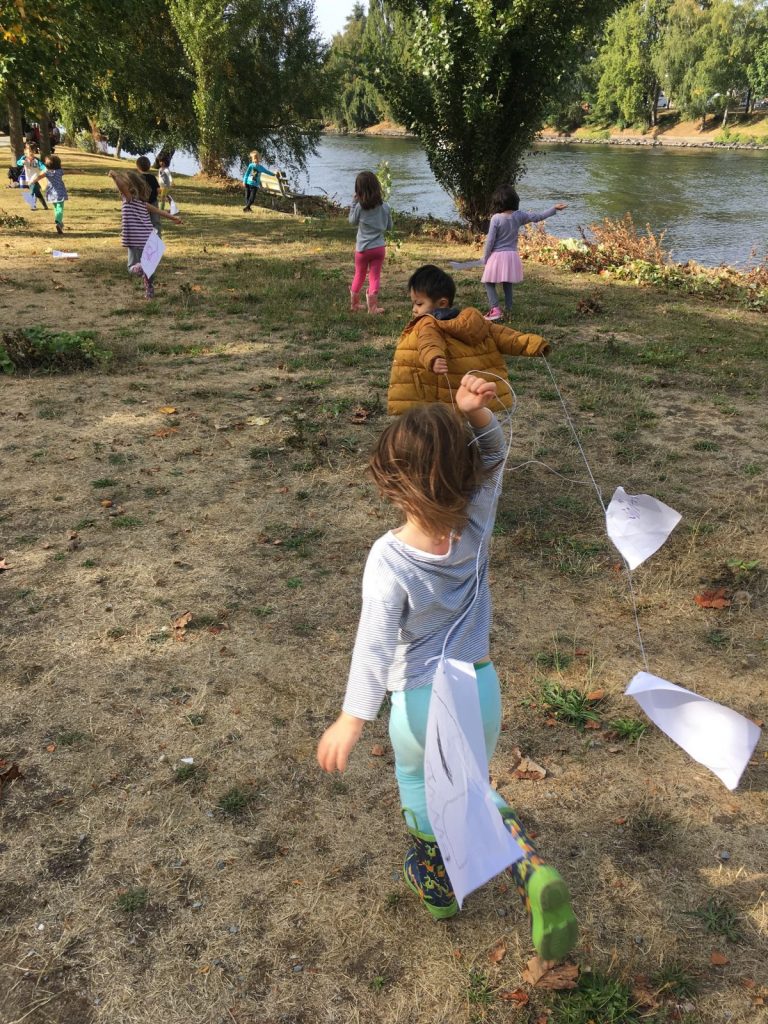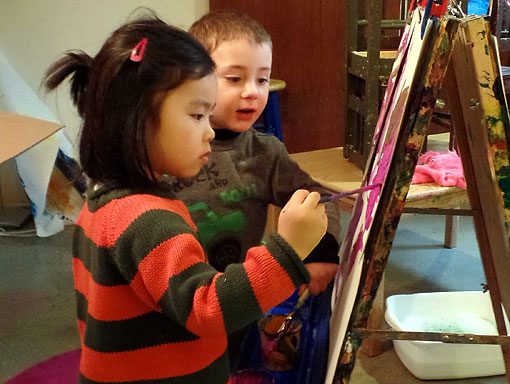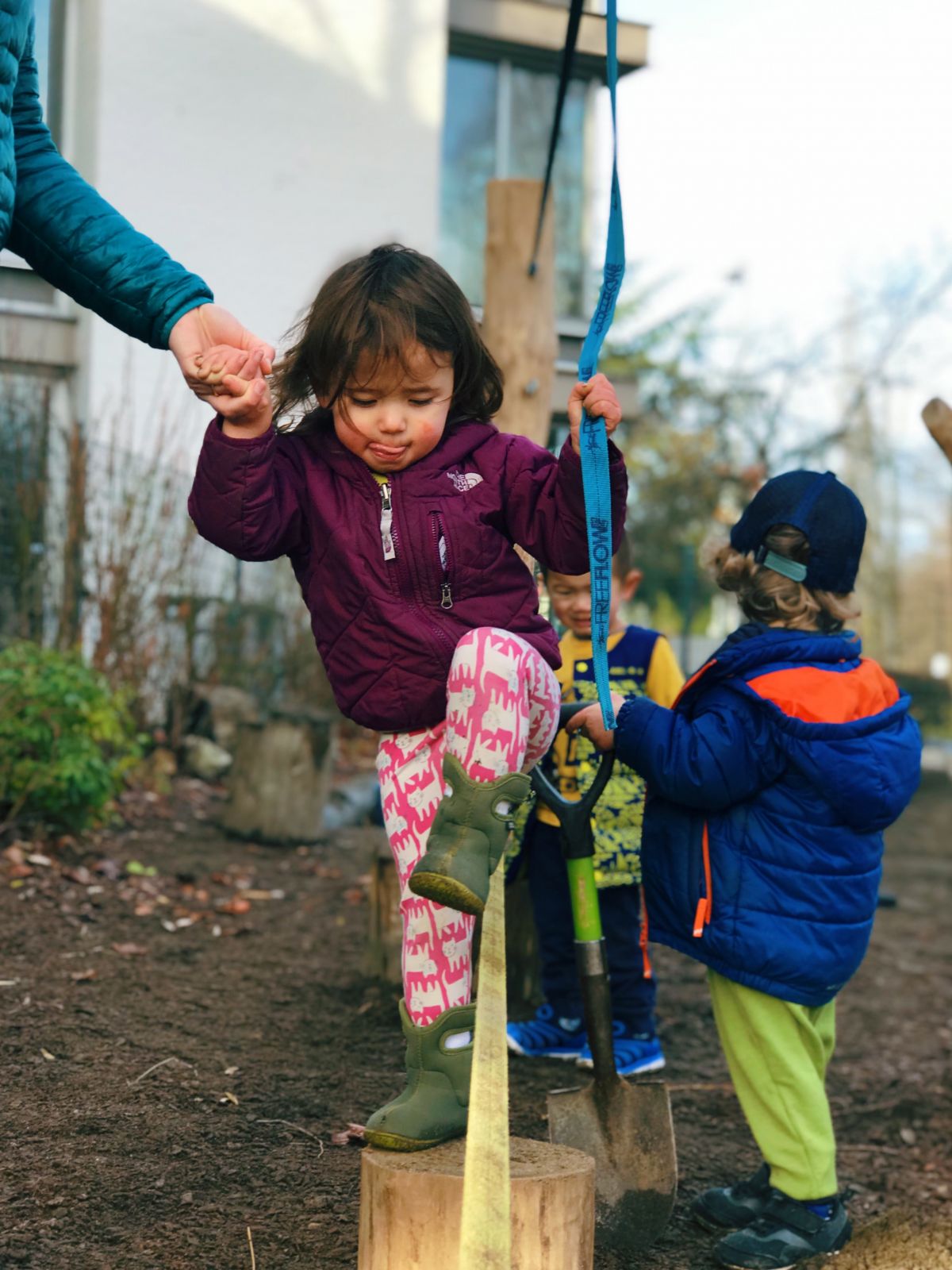
New Year, New Classroom
[et_pb_section fb_built=”1″ _builder_version=”3.22″ fb_built=”1″ _i=”0″ _address=”0″][et_pb_row _builder_version=”3.25″ background_size=”initial” background_position=”top_left” background_repeat=”repeat” _i=”0″ _address=”0.0″][et_pb_column type=”4_4″ _builder_version=”3.25″ custom_padding=”|||” custom_padding__hover=”|||” _i=”0″ _address=”0.0.0″][et_pb_text _builder_version=”3.27″ hover_enabled=”0″ _i=”0″ _address=”0.0.0.0″]
With summer in full swing, educators in the Rainbow Classroom at Hilltop are gearing up for our biggest transition of the year, when we send our group of now-3-year-olds into their new classrooms. They are ready for this move and it is becoming more apparent with each passing day that they are outgrowing Rainbow room. Despite the necessity of move-ups, this process can be scary for children and families who have never experienced another classroom environment or teacher outside of their child’s first year of Rainbow Room. In order to be responsive to these emotions, we prepare families and children for this transition in small and big ways throughout the year they spend with us.
The three primary ways we create and encourage successful future years of schooling for children and families within our classroom are to:
- Teach small transitions throughout the day
- Work on finding positive coping skills for big emotions
- Define community broadly to encourage inclusivity
 From the first day of school in our classroom, we start teaching the children the small, frequent transitions that we utilize to create structure to our day. We work with families to create a drop-off and pick-up routine, which will encourage both the child and adult to learn their role during the drop-off and pick-up transition. This can be as simple as a hug goodbye, pushing their adult out the classroom door, reading a story with their adult before saying goodbye, or finding an activity to work on with their adult for a couple of minutes. We focus on transitioning in and out of play, although this is one transition we try to keep minimal (to give the children large amounts of uninterrupted play). In our classroom, children primarily have to enter and exit play to use the restroom or eat breakfast/snack. We work on how to physically transition from the indoor classroom to our outdoor time twice daily. We learn how to calm our body down before we can transition our body from active play to rest time during nap.
From the first day of school in our classroom, we start teaching the children the small, frequent transitions that we utilize to create structure to our day. We work with families to create a drop-off and pick-up routine, which will encourage both the child and adult to learn their role during the drop-off and pick-up transition. This can be as simple as a hug goodbye, pushing their adult out the classroom door, reading a story with their adult before saying goodbye, or finding an activity to work on with their adult for a couple of minutes. We focus on transitioning in and out of play, although this is one transition we try to keep minimal (to give the children large amounts of uninterrupted play). In our classroom, children primarily have to enter and exit play to use the restroom or eat breakfast/snack. We work on how to physically transition from the indoor classroom to our outdoor time twice daily. We learn how to calm our body down before we can transition our body from active play to rest time during nap.
In the beginning of the year, our day is spent primarily focusing on these small moments of emotional, physical, and mental transition with the children with the support of extensive scaffolding for success, while also seeking to build relationships. As the year progresses, along with our relationships, we find that less scaffolding is necessary. Often we notice that well before the end of the year, the kids have learned these routines, finding comfort in the known practices of transitions despite their emotions at any given moment.
Speaking of emotions, the second way we prepare children for their big move-up transition to a new classroom is through focusing throughout the year on positive coping skills for times when sad, angry, or scared emotions arise. Just like the process of the children learning their transitional routines, we also scaffold this emotional regulation through providing language when necessary and consistently talking about/labeling emotions, encouraging communication of peers when applicable, and verbally modeling the next steps a child should consider taking. It may not be hard to imagine this scenario: a child is working with deep concentration in the block area and a teacher lets them know it’s time to try to use the toilet. The child gets mad, knocks over their blocks, and starts yelling. As the teacher in this scenario, we would get close to the child, saying, “I can see you knocked over your tower and started yelling. That makes me think you are feeling mad.” Depending on the child and situation, we may wait for a response or follow-up with, “It is okay for you to feel mad, but I am not okay with you yelling at me. You seem like you need some space to calm down.” We would then help the child find a place to take some time until they were ready to return to have a conversation and/or do the required job.
This practice helps the children identify their emotions and over time, they will even begin to identify and address them independently. This emotional regulation that occurs is a natural part of development at three years old, and the modeling of these emotions and what to do when feeling them helps the children figure out how to cope with big feelings. These big feelings arise in the classroom daily, but also will likely have a spike in frequency during times of big transition, such as moving to a new classroom. When children know what to do during these emotionally overwhelming moments, it puts power and control into their hands making them successful in future hard times.

One other way that we work on this transition from day one in our classroom is to define our community broadly to encourage the child to see that we are inclusive of all people who help shape us, not just the kids we play with on a daily basis. Our classroom community includes the children, the teachers, the families of the children and the families of the teachers. It also may include any other person that the kids want us to know about, such as a special grandparent, cousin, friend, neighbor, or pet. We talk about these people, animals, and even imaginary friends/beings in our daily work with the children because when we listen to the kids tell us their definition of “community” this is who they include. We talk about our Hilltop community as we pass other classrooms in the halls, talk about other project work that various classrooms are engaged in, and visit/play with other classes and kids. In Rainbow Room this often looks like getting to know the classroom across the hallway that we share a common bathroom and art studio with. The children become so comfortable with one another over the year that we see cross-class friendships form, with children asking to “visit” their friends’ classroom during our open playtime. We also talk about the broader “Seattle” community that the children are a part of, as we explore the city on walks and field trips. Due to this openness of how we define the communities that the children are a part of, we are working towards the idea that communities can include people that you may not see or engage with as often as the people you see daily. This is comforting to many children as they think about moving into their new classroom because they know that their current friends and teachers can still be a part of their community regardless of whether or not we are all in the same classroom. It also encourages them to be thinking about the new friends that can join their community as they meet new people.
 Our goal is to build onto the children’s first successful year of school. They have laughed, cried, and built a community together for a year or in other terms, nearly a third of their life has been spent with the kids and teachers in their classroom community. As adults, we can admit that change can feel scary, hard, or exciting (or all of the above!) depending on the individual experiencing it. The end of that daily classroom community, as they know it, can feel heartbreaking, but when we show them the new possibilities for their future years of preschool (and schooling beyond Hilltop), they are able to see glimpses of a new possible community. A community that is broader than their previously more narrowly defined version allows for them to dream of new friends and teachers. New relationships will form and these Rainbow kids will be ready to build relational connections with others due to an increased capacity for emotional regulation and positive coping skills, a strong sense of managing transitions, and the knowledge that community doesn’t solely include their classmates, but their family, friends who are in different classes, and even teachers from previous years!
Our goal is to build onto the children’s first successful year of school. They have laughed, cried, and built a community together for a year or in other terms, nearly a third of their life has been spent with the kids and teachers in their classroom community. As adults, we can admit that change can feel scary, hard, or exciting (or all of the above!) depending on the individual experiencing it. The end of that daily classroom community, as they know it, can feel heartbreaking, but when we show them the new possibilities for their future years of preschool (and schooling beyond Hilltop), they are able to see glimpses of a new possible community. A community that is broader than their previously more narrowly defined version allows for them to dream of new friends and teachers. New relationships will form and these Rainbow kids will be ready to build relational connections with others due to an increased capacity for emotional regulation and positive coping skills, a strong sense of managing transitions, and the knowledge that community doesn’t solely include their classmates, but their family, friends who are in different classes, and even teachers from previous years!
Success in school has a plethora of meanings depending on who you ask, but for the teachers who are in community with the Rainbow Room, it looks like kids finding joy and community, not dependent upon who their new teachers and classmates are, but dependent upon their ability to care for themselves, physically, mentally, and emotionally; and their ability to see that the big, diverse world is broader than themselves, their immediate surroundings, and the people closest to them. We will continue to advocate for children moving to a new classroom and prepare them for these changes ahead.
Each year we discuss move-ups with the children beginning in July and continuing into the end of summer. We will be engaging in classroom visits, which will begin with visiting the new classrooms when they are not full of children; progressing into visiting the classrooms for older children in small groups with a current teacher when Sunlight, Mountain, and River kids are in their classrooms; and finally, some visits where the current teacher drops the kids off in their new classrooms for brief visits before the full-time transition occurs. We have found great success in this process in the past and expect for this to help the children acclimate to the idea of a new classroom with new teachers. We will present the children with a “move-up” medallion, post photos of the children in their move-up specific groups in our classroom, and dialogue about their new classrooms and teachers delving into any emotions the children are expressing.
Chauntae is an educator with 2- to 3-year-olds at Hilltop Children’s Center, where she has worked since 2017.
While most anti-bias curriculums begins by focusing on the children and families – creating the foundation for valuing differences – some organizations forget to focus on the staff that represents their programs. By raising awareness about white privilege and institutional racism, programs can implement strategies to create an equitable learning environment to ensure each child is visible, validated, and valued. Join us for either one of our Educator Discussion Series workshops which focus on issues of equity and inclusion in early childhood education, or for a Study Day focused on the intersection of Anti-Bias Education and Reflective Practice. Email Mike at institute@hilltopcc.org for more information.
[/et_pb_text][/et_pb_column][/et_pb_row][/et_pb_section][et_pb_section fb_built=”1″ admin_label=”section” _builder_version=”3.22″ fb_built=”1″ _i=”1″ _address=”1″][et_pb_row admin_label=”row” _builder_version=”3.25″ background_size=”initial” background_position=”top_left” background_repeat=”repeat” _i=”0″ _address=”1.0″][et_pb_column type=”4_4″ _builder_version=”3.25″ custom_padding=”|||” custom_padding__hover=”|||” _i=”0″ _address=”1.0.0″][/et_pb_column][/et_pb_row][et_pb_row _builder_version=”3.25″ background_size=”initial” background_position=”top_left” background_repeat=”repeat” _i=”1″ _address=”1.1″][et_pb_column type=”4_4″ _builder_version=”3.25″ custom_padding=”|||” custom_padding__hover=”|||” _i=”0″ _address=”1.1.0″][/et_pb_column][/et_pb_row][/et_pb_section][et_pb_section fb_built=”1″ _builder_version=”3.22″ fb_built=”1″ _i=”2″ _address=”2″][et_pb_row _builder_version=”3.25″ background_size=”initial” background_position=”top_left” background_repeat=”repeat” _i=”0″ _address=”2.0″][/et_pb_row][/et_pb_section][et_pb_section fb_built=”1″ _builder_version=”3.22″ fb_built=”1″ _i=”3″ _address=”3″][et_pb_row _builder_version=”3.25″ background_size=”initial” background_position=”top_left” background_repeat=”repeat” _i=”0″ _address=”3.0″][/et_pb_row][/et_pb_section]